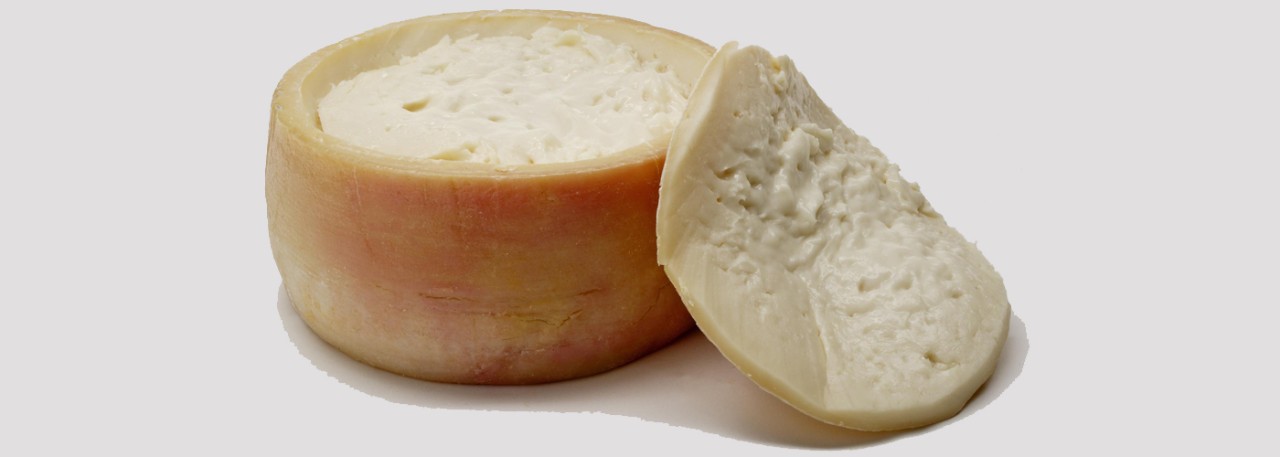.png.transform/rendition-xs/image_image%20(1).png)
Queso de La Serena PDO
Soft to semi-hard cheese made from whole, raw milk from ewes of the Merino breed, and cured for a minimum of 20 days.
Tasting notes
Characteristic aroma of ewes’ milk, with an intense, slightly bitter flavor and not at all salty. Buttery and persistent on the palate, with a slight piquancy in very ripe cheeses. The texture varies from creamy to spreadable.
Other notes
Cylindrical in shape with flat top and bottom and convex sides. 4-8 cm (1½-3”) high, 18-24 cm (7¼-9½”) in diameter and 750g-2 kg (1 lb 10 oz–4 lb 6 oz) in weight. The rind is semi-hard, a waxy yellow or ocher color, with lightly oiled, smooth top and bottom surfaces. The sides may be smooth or bear the marks of the wicker molds. The consistency varies from soft to semi-hard, and the color from ivory to waxy yellow. There may be small, unevenly distributed holes. In well-ripened cheeses, the paste and the rind are hard. Fat content must be at least 50% of dry matter. pH must be 5.2-5.9 and total protein at least 35% of dry matter.
Production / Processing method
The milk must be the whole natural product obtained from milking healthy ewes. It must be clean and contain no colostrum, medications or preservatives that might have a negative effect on the production, ripening and keeping qualities of the cheese and on its health and hygiene conditions.
The milk from 15 ewes is needed to make one kilogram (2 lb 3 oz) of cheese. First the milk is coagulated using natural plant rennet from the dried flowers of Cynara Cardunculus, known locally as Yerbacuajo. The pistils of these thistles are soaked in water for twelve hours in a cool, dark place. The amount of rennet to be added depends on the time of year and the desired level of creaminess.
For coagulation the milk must be at 25-32ºC (77-89ºF) for 50-75 minutes. Once the curds have formed, they are then cut until they form grains with a diameter of 10-20 mm (0.4-0.8”).
The medium temperature and the use of natural rennet make the coagulation period long and lead to fairly soft curds, with the proteolytic activity giving a less consistent texture but high dry matter content. The curds are then poured into molds formed out of plaited esparto grass bands or cylindrical metal or plastic molds to give cheeses of the right shape, size and weight. This process is carried out on a sloping work surface.
The cheeses are then salted either by rubbing dry salt onto the surface by hand or by immersing them in a 20% saline solution for a maximum of 24 hours. Finally, the cheeses are placed on wooden shelves in a storage room called a bodega or cellar where they are ripened under constant moisture and temperature conditions.
They are turned and the bands are tightened every day until they achieve the characteristic degree of creaminess and flavor. 20 days after molding, the cheeses usually reach the stage at which the paste becomes fluid, so they have to be handled very carefully to avoid breaking the rind.
Geography / Relief and climate
The topography of the province of Badajoz is mostly peneplain at an average altitude of 430 m with gentle slopes mostly facing south. The La Serena district in the north-east of the province forms part of the southern sub-meseta of the Extremadura peneplain and is almost completely treeless.
The geological structure is that of a Paleozoic peneplain with some subsequent coverings and numerous eruptive outcrops. The terrain is shallow, averagely permeable Cambrian, Silurian and granitic, with very frequent outcrops of parent rock.
Soils are under-developed and acid, with pH of 5-5½ and low levels of phosphorus. They lie on slate bedrock with excellent-quality granite outcrops so that grass grows well even with very little water.
Although most of the land is used for grazing, the pastures are scarce but of excellent quality, giving special characteristics to the locally-produced milk. Winters are usually mild, although frost is frequent from 1 November to 10 March, and summers are hot and dry. The whole area is arid, with average annual rainfall of 498 mm (19.6”).
Regulatory Council
Consejo Regulador de la DOP Queso de La Serena
Institución Ferial de la Serena - Ctra. Ex-104, s/n
Apartado Correos 32
06420 Castuera (Badajoz)
Extremadura
Tel: (+34) 924 772 114
info@quesoserena.com
www.quesoserena.com
Sources:
- Spanish Ministry of Agriculture
The sides may be smooth and bear the marks of the wicker molds. The consistency varies from soft to semi-hard, and the color from ivory to waxy yellow.


- Serena 1
- Serena 2

Castuera - Badajoz (Extremadura)
